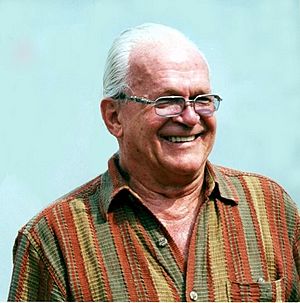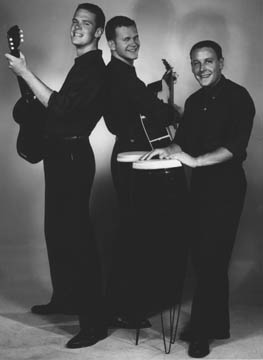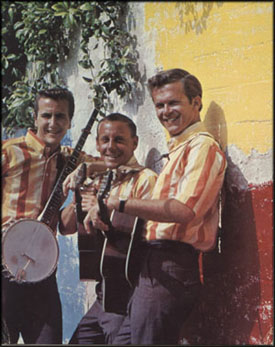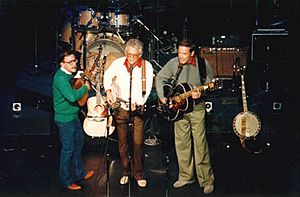Bob Shane facts for kids
Quick facts for kids
Bob Shane
|
|
|---|---|

Bob Shane, 2004
|
|
| Background information | |
| Birth name | Robert Castle Schoen |
| Born | February 1, 1934 Hilo, Territory of Hawaii, U.S. |
| Died | January 26, 2020 (aged 85) Phoenix, Arizona, U.S. |
| Genres | Folk, pop |
| Occupation(s) | Singer, guitarist |
| Instruments | Vocals, guitar, banjo |
| Years active | 1957–2004 |
| Labels | Capitol Records, Decca Records, other |
Robert Castle Schoen (born February 1, 1934 – died January 26, 2020), known as Bob Shane, was an American singer and guitarist. He was one of the people who started The Kingston Trio. This group helped make folk music popular in the United States from the late 1950s to the mid-1960s.
The Kingston Trio became very successful. They sold many albums, with four of their albums being in the Top 10 at the same time in 1959. Their success brought acoustic, folk-based music from a small group of fans to become popular with many people. This opened the door for big record companies to sign other folk musicians and singer-songwriters.
Contents
Bob Shane's Early Life
Bob Shane was born on February 1, 1934, in Hilo, on the Big Island of Hawaii. His father, Arthur Castle Schoen, sold toys and sports goods. His mother, Margaret, was from Salt Lake City. Bob Shane said he was a "fourth-generation islander," meaning his family had lived in Hawaii for a long time.
He went to local schools, including Punahou School for junior high and high school. At Punahou, he learned about native Hawaiian culture. This helped his interest in music, especially Hawaiian music. During these years, Shane taught himself to play the ukulele and then the guitar. He was inspired by Hawaiian slack key guitar players like Gabby Pahinui. He also met his classmate Dave Guard at Punahou. They started performing together at parties and school shows.
Starting The Kingston Trio
After graduating in 1952, Shane went to Menlo College in Menlo Park, California. Dave Guard went to nearby Stanford University. At Menlo, Shane became good friends with Nick Reynolds. Nick was also a musician and singer who knew many folk and popular songs. Shane introduced Reynolds to Guard. In 1956, the three started playing music together. They were part of a casual group that sometimes had as many as six or seven members. They used different names, often "Dave Guard and the Calypsonians." They mostly played for fun and didn't plan to become professional musicians. Shane left college in his last year and went back to Hawaii to work in his family's business.
However, Shane loved performing. At night, he started a solo music career in Hawaii, playing at big hotels in Waikiki. He sang a mix of songs from artists like Elvis Presley, Hank Williams, and Harry Belafonte. During this time, he met the famous blues musician Josh White. Josh White helped Shane improve his guitar playing style. He also encouraged Shane to use a Martin "Dreadnought" guitar to support his singing. This led to Shane's long connection with Martin guitars. Later, the company even made special "signature" guitars to honor Shane and the Kingston Trio.
Meanwhile, in California, Guard and Reynolds formed a more formal group called "The Kingston Quartet." It included bassist Joe Gannon and singer Barbara Bogue. This group played one night at a club in San Francisco. They invited publicist Frank Werber, who had seen Shane, Guard, and Reynolds play before. Werber liked Guard and Reynolds but thought the group would be better as a trio. When Gannon and Bogue left, Reynolds, Guard, and Werber all agreed that Shane should be the third member. Shane returned to California in the spring of 1957. Bob Shane's deep voice and guitar playing became a key part of the Kingston Trio's sound.
Shane, Guard, Reynolds, and Werber made an agreement to work together. They chose the name "Kingston Trio." They thought it sounded like the popular calypso music from Kingston, Jamaica. It also sounded like the "college" style they wanted, which they showed with their matching striped shirts.
The Kingston Trio's Peak Years: 1957–1967
Under Frank Werber's strict guidance, Shane, Guard, and Reynolds practiced almost every day for several months. They even got lessons from a famous vocal coach, Judy Davis. Their first big chance came in the summer of 1957. Comedian Phyllis Diller canceled a show at The Purple Onion, a small San Francisco club. Werber convinced the club to hire the new trio for a week. The trio's close harmonies, different songs, and well-practiced but natural stage humor made them an instant hit. Their one-week show turned into six months.
During this time, Werber used the trio's local popularity to get interest from record companies. After some tries, the group signed a contract with Capitol Records. They recorded their first album in just three days in February 1958. The producer was Voyle Gilmore. He made two important decisions:
- He wanted the trio's acoustic sound to have a stronger "bottom," so he added a bass player to the recordings.
- He decided the group should be recorded without extra orchestra music, which was unusual then.
Both decisions became typical for almost all of the Kingston Trio's future recordings and live shows.
Their album, The Kingston Trio, came out in June 1958. At the same time, the group started a long show at San Francisco's bigger Hungry i night club. The album included "Scotch and Soda," which became Bob Shane's famous song. It also featured his strong guitar playing and an old murder ballad called "Tom Dooley," where Shane sang the main part.
In the summer of 1958, while Shane and the Trio were playing in Honolulu, a DJ in Salt Lake City started playing "Tom Dooley" from their album. Other DJs across the country followed. People loved the song, so Capitol Records released it as a single on August 8, 1958. It quickly became the number one song on the music charts. It sold a million copies before Christmas 1958 and earned the Kingston Trio their first of eight gold records and two Grammys.
This began a time of amazing success for Shane and the Trio. In 1959 alone, they released four albums. Three of them reached number one, and all four were in Billboard's Top Ten in December 1959. Only The Beatles have done something similar. Thirteen of their albums made it into Billboard's Top Ten, with five reaching number one. Their first album stayed on the charts for 195 weeks. Several of their singles also made it into the Top 100. The group played over 200 shows a year for several years. They were pioneers in playing concerts at colleges and performed at many top night clubs, festivals, and theaters.
However, during this time, problems started between Shane and Guard. They disagreed about the music style of the Kingston Trio and about money and song rights. Because of these disagreements, Guard decided to leave the group in the spring of 1961. Shane, Reynolds, and Werber bought Guard's share of the group. They quickly found a replacement: John Stewart. He was a young folk singer and songwriter who had already written songs the Trio had recorded. The Kingston Trio with Shane, Reynolds, and Stewart stayed together for another six years. They released nine more albums with Capitol Records and had several hit songs. But as the folk music trend slowed down and other big bands like The Beach Boys and The Beatles became popular, their record sales dropped. The group then moved to Decca Records. They released four more albums before breaking up after a final show at the Hungry i in June 1967.
Solo Work and The New Kingston Trio: 1969–1976
Bob Shane did not want the Kingston Trio to break up. He believed the group could change with new music styles. He was also a very good entertainer and marketer by then. Shane decided to stay in the music business. He tried working alone, recording several songs. One of them was the original version of "Honey," which later became a million-seller for Bobby Goldsboro. He also tried different groups with other folk musicians.
In 1969, he asked Reynolds and Werber, who were still his partners, if he could use the group's name. They agreed, but only if Shane put together a group that was as good as the original ones. They also said he had to add "New" to the name. Shane formed two groups called "The New Kingston Trio."
- The first group included guitarist Pat Horine and banjo player Jim Connor, along with Shane. This group lasted from 1969 to 1973.
- The second group had guitarist Roger Gambill and banjo player Bill Zorn. This group played from 1973 to 1976.
Shane tried to create a mix of songs for these groups. He included classic Kingston Trio songs like "Tom Dooley" and "M.T.A.." He also added more modern songs, including country and funny tunes. But these new groups were not very successful. Even though they made some recordings and appeared on TV, they didn't get much attention from fans.
Another Kingston Trio, Reunion, and Retirement: 1976–2004
At the end of 1976, Bill Zorn wanted to start a solo career and left the group. To replace him, Shane found a younger musician named George Grove, who played instruments and sang. Shane realized that the group's biggest strengths were his own singing, his presence as a founding member, and the name "Kingston Trio" itself. So, he bought the rights to the Kingston Trio name from Reynolds and Werber. Since late 1976, all of Shane's groups have been known simply as the Kingston Trio.
In 1981, PBS producers JoAnn Young and Paul Surratt suggested an idea to Shane. They wanted to film a reunion concert for PBS to use for fundraising. This concert would include Shane's current group and also bring together the two original Kingston Trio lineups with Dave Guard and John Stewart. Shane and the others agreed. The concert was held and filmed at the Magic Mountain amusement park in Valencia, California, in November 1981. It was shown on PBS stations in March 1982.
Even though there was some tension between Guard and Shane, the concert was a success. It became an important event in Kingston Trio history. Over the next nine years, Shane and Guard became friends again. Guard was battling cancer, but it seemed to be getting better when Shane and Reynolds visited him in New Hampshire in the summer of 1990. The three talked about a reunion tour that would include Shane's current group (which by then had a re-energized Nick Reynolds) as well as Guard and Stewart. However, Guard's cancer returned, and he died in March 1991. Bob Shane was the only member from any Kingston Trio group to sing at Guard's memorial service.
After Shane bought the Kingston Trio name in 1976, the people in the group changed several times. But Shane and Grove remained constant members. Shane led the group to continued success. While it never reached the same level as the group's first ten years, it was steady and reliable. Shane's Kingston Trio mostly played their "greatest hits" along with other songs that fans had come to love as part of their shows.
In March 2004, a month after his 70th birthday, Shane had a serious heart attack. This forced him to stop touring and performing after 47 years with the group. Shane had hoped to return after getting better, but the attack was severe. He had to permanently stop performing with the group he still owned. Former New Kingston Trio member Bill Zorn replaced him.
Personal Life
Bob Shane was married to Louise Brandon for 23 years. They had five children and eight grandchildren. Their marriage ended in divorce. He remarried in 2000 to Bobbi Childress.
He passed away on January 26, 2020, at a hospice facility in Phoenix, Arizona.
Discography and Videography




